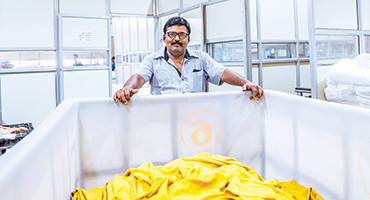Always open
November 26, 2019Supply chain transparency serves operations and reputations
BY STUART FOXMAN
THE VT Garment Co. in Thailand is a Fair Trade Certified factory. Every purchase of goods made there sends more money back to the 1,500 workers. They earn premiums they can turn into cash, a collective social investment or both. Employees voted to put their first premium disbursements towards school fees for their children.
At Hirdaramani-CKT Apparel in Sri Lanka, the workers had a similar vote. They chose to use their Fair Trade premiums to open a free daycare centre, and start a health and hygiene program. Both changes have boosted the team’s physical and mental wellbeing, leading to not only higher satisfaction but also greater productivity.
Each plant serves Patagonia, a designer of outdoor clothing and sports gear. The company has over 100 retail stores worldwide, including two in Canada. The Thailand and Sri Lanka stories are prominent on a section of Patagonia’s website called The Footprint Chronicles. It maps what’s happening at their textile mills, factories and farms.
For Patagonia, it presents an opportunity to be transparent about their supply chain. They report on what they do around living wages, recycled and organic materials, safe and humane working conditions, environmental impacts, and more.
Labels only tell you so much. If you want to know what brands are really made of, consider the entirety of the supply chain. More and more retailers are tracking and reporting theirs more closely, to reduce operational, reputational and legal risks.
“I see transparency as a competitive strategy,” says Leonardo Bonanni, founder and CEO of Sourcemap.
His company helps manufacturers and brands trace products from raw materials to consumers. Bonanni says it’s becoming best-in-class to disclose who makes your products, and how, at every stage of the supply chain.
Defining priorities
Before you can determine if you’re being transparent, you need to figure out what to be transparent about.
The Global Supply Chain Institute (GSCI) talks about aligning the management of end-to-end supply chain activities with social, environmental, and economic goals. That could entail looking at everything from labour practices to sustainability. The objective: systemically improve longterm organizational performance.
The GCSI mentions three related imperatives. The first two are visibility (the ability to see across the supply chain), and traceability (tracking goods across the chain).
The third, transparency, comes from proactively communicating relevant information (e.g. health, safety and ethics) to stakeholders like consumers, shareholders, suppliers, governments/agencies, NGOs and employees. That could relate to supply chain products, materials, services and systems (manufacturing, warehousing, transportation, etc.).
There are still obstacles to progress. One challenge is silos in companies, says Delaney Greig, Manager of Engagement and Policy at the Vancouver-based Shareholder Association for Research and Education (SHARE).
SHARE is a non-profit organization that works with institutional investors to help them become active owners and develop responsible investment practices. There can be a tension within companies, says Greig. While some personnel are tasked with social responsibility and sustainability efforts, buyers are focused on moving products by deadlines. Some might feel that these interests compete.
“Overcoming that internally is a huge issue,” says Greig. “Creating real change is difficult. That’s where management comes in.”
In fact, greater diligence regarding the supply chain can lead to widespread benefits as well as mitigate risks. SHARE points to a reduced chance of court actions (by consumers, investors or workers), and less supply disruption or blocked shipments (e.g. of goods made with forced labour; see sidebar).
Bonanni adds that you can also achieve better quality control, improve deliveries, achieve higher social/environmental compliance, and identify all sorts of incremental improvements in supply chain efficiency. Companies with more sustainable and transparent supply chains might also attract better talent to their companies.
Market share is another benefit of supply chain transparency. Consumers vote with their wallets, possibly paying a premium for goods.
Alexis Bateman, Director of MIT Sustainable Supply Chains (an initiative in the MIT Center for Transportation & Logistics), says the evidence is mixed on that front. What you do see, sometimes, is more brand loyalty.
“It’s not just about whether consumers are willing to buy. It’s about trustworthiness. Do consumers trust you to do the right thing?” she says.
To Bateman, sending consumers a message shouldn’t be the sole motivation for supply chain transparency. You need to make a more comprehensive ROI case. “The driver has to be reducing risks to the business,” she says
Where to start?
“It’s almost an archaeological process,” says Bonanni. Technology can make it easier. His firm uses tools like geo-visualizations, network diagrams, and geo-analytics (depending on the commodity and risk they want to focus on).
Firms need to manage and monitor results from a range of their tiered suppliers. It can be hugely complex. Each company will have its own priorities, depending on its products, operational considerations and stakeholder demands. This is a methodical and ongoing endeavour (see sidebar).
“What are the pressure points?” says Bateman. “If you just say, ‘I want more transparency in my supply chain’, you’ll go on a wild goose chase. Most people start with laying out a code of conduct with their direct suppliers and ensure that waterfalls to their indirect suppliers.”
With Ikea, for instance, the IWAY supplier code of conduct sets requirements around environment, social and working conditions. That’s a pre-condition for doing business with Ikea, and all suppliers are responsible for communicating IWAY to their sub-suppliers.
“We’re working to secure the best possible transparency in our relationships. This is an incredibly important aspect of our business,” says Kristin Newbigging, a spokesperson for Ikea Canada.
There is no standard way to report on your supply chain. Websites, CSR publications, information on packaging and reports verified by third parties are all viable strategies. What matters most is using robust measurements.
Greig says that supply chain reporting can be lacking in contrast to financial reporting. Sometimes, the reporting isn’t quantitative enough, or it talks about ambitions instead of achievements. Stories can be great, she says, as long as they’re actually representative and not one-offs.
Reporting isn’t just about touting your own achievements. Newbigging notes that being open and transparent allows others to learn from your successes, your failures and challenges too, as well as ways of working.
What does the future hold for supply chain improvements and transparency? Making substantial progress depends in large part on crossindustry efforts, says Bateman.
There’s power in numbers. Bateman would like to see existing industry associations raise minimum expectations, nurture partnerships, and use their platform to share best practices. Each industry, she says, has different pressures on their practices, or ills in their supply chains.
Improvements can reduce risks, save costs and support your values. Transparency, says the GSCI, provides evidence that the company is making the right decisions every day.
For retailers, the ultimate impact on customers matters. Still, “Customers aren’t the agents of change,” says Greig. “When corporate leadership, employees and investors care about something, that’s when change happens. Transparency becomes the accountability part of it.”
A CONTINUOUS JOURNEY
Last year, professional services firm EY issued a study on transparent supply chains. They said that to control uncertainties, it’s important to view supply chains in a holistic way. “Building a responsible and resilient supply chain is a continuous journey,” states the report, and happens by design. EY suggests a five-phase model.
- Phase 1: Hot spot analysis. Get a good understanding of the risks and impacts in the supply chain, including sub-tier suppliers. For a full picture, analyze risks in all main and interrelated categories. The challenge is reducing the number of hot spots to address through specific mitigation tools.
- Phase 2: Quantify risks and opportunities. Assess the current supply chain model with indicators like governance, processes, people and technology. Use scenario-planning techniques to examine the impact of changes to key supply chain performance drivers.
- Phase 3: Develop an issue-specific program. That includes supplier assessments, controls, stakeholder management, and possibly training for suppliers.
- Phase 4: Implementation program design. Integrate this into the existing business process, so it won’t be seen as a separate project. Use a proper KPI framework to generate relevant information to follow the strategic objectives.
- Phase 5: Reporting and continuous improvement. Measure and communicate the results to internal and external stakeholders.
THE SCALE OF MODERN SLAVERY
Human rights and labour standards are a big focus of supply chain transparency, says Delaney Greig of SHARE. A new report from the non-profit, in collaboration with the Schulich School of Business’ Centre of Excellence in Responsible Business and World Vision Canada, puts the spotlight on modern slavery.
“Every company is at risk of having modern slavery in its direct operations or supply chains regardless of region, industry, geography or company size,” the report states.
The report, the first of its kind in Canada, defines modern slavery as forced labour (including bonded labour, slavery and human trafficking) and child labour. Estimates are that 25 million people globally are in forced labour, and 152 million others are in child labour (almost half of those in hazardous work).
As the report notes, previous research found that over $34 billion of goods imported into Canada each year are at high risk of having been produced by forced or child labour. More than 1,200 companies operating in Canada were identified as having imported one or more of these high-risk goods.
In the report, 76 per cent of companies said that supply chain legislation could benefit their company by driving action to address modern slavery
“It’s not just about whether consumers are willing to buy. In general, it’s about trustworthiness. Do consumers trust you to do the right thing?”
ALEXIS BATEMAN MIT Sustainable Supply Chains




